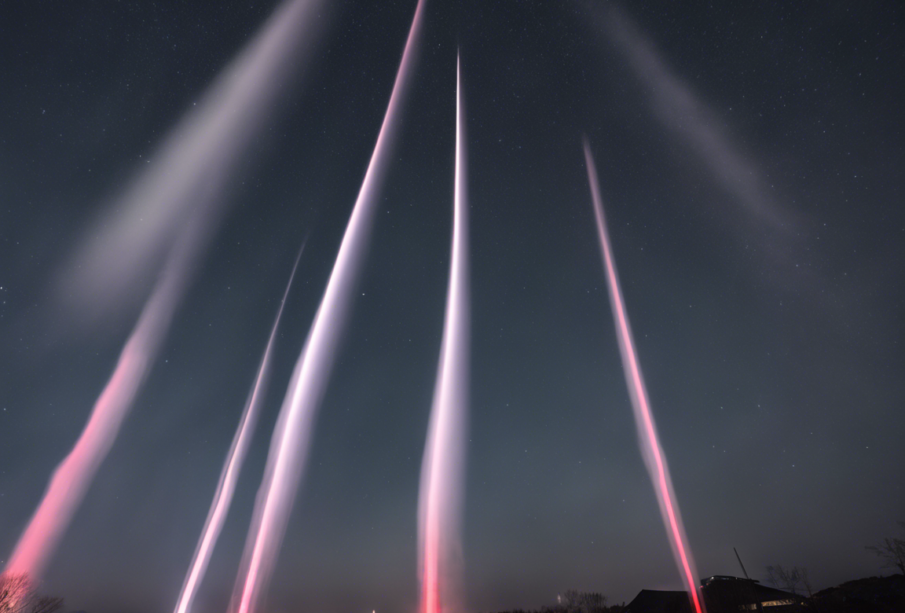Capturing the Enchanting Beauty of Japanese Light Pillars

Standing in awe as the sun sets behind the intricate silhouette of pagodas, witnessing the vibrant neon lights reflecting off the bustling streets of Tokyo, or being mesmerized by the serenity of a traditional Japanese garden… Japan’s mesmerizing beauty is intertwined with its unique relationship with light. Among the many captivating natural phenomena that showcase Japan’s enchanting allure are the Japanese light pillars, a spectacular sight that illuminates the night sky in a breathtaking display.
Understanding Light Pillars
Light pillars are a mesmerizing optical phenomenon that occurs in cold climates when light is reflected off the surfaces of falling ice crystals in the atmosphere. This phenomenon creates vertical shafts of light that extend above or below the light source, resembling pillars reaching towards the heavens. The light pillars are most commonly seen during cold winter nights when the air is crisp and still, allowing the ice crystals to form stable, hexagonal shapes that reflect and refract light in a spectacular display.
Chasing Light Pillars in Japan
Japan, with its unique geography and climate, offers the perfect conditions for witnessing and capturing the beauty of light pillars. From the northern island of Hokkaido, known for its frigid winters and stunning landscapes, to the urban centers of Tokyo and Kyoto, where modernity blends seamlessly with tradition, Japan provides a diverse range of settings to experience this captivating natural phenomenon.
Best Places to Witness Light Pillars in Japan
-
Hokkaido: The cold winters and clear night skies of Hokkaido make it an ideal location to witness light pillars. Head to areas like Sapporo or Asahikawa for a chance to capture this ethereal spectacle against the backdrop of snow-covered landscapes.
-
Tokyo: The vibrant cityscape of Tokyo offers a unique contrast to the natural beauty of light pillars. Visit popular spots like Shinjuku or Shibuya to capture the mesmerizing reflection of neon lights off the icy winter air.
-
Kyoto: Experience the juxtaposition of ancient temples and modern light pillars in Kyoto. Explore locations like Kiyomizu-dera or Fushimi Inari Taisha for a surreal blend of tradition and nature.
-
Nagano: Known for its picturesque mountain vistas, Nagano provides a stunning backdrop for witnessing light pillars. Head to the snow-covered landscapes around Jigokudani Monkey Park for a chance to capture this enchanting phenomenon.
Tips for Photographing Light Pillars
-
Timing: The best time to capture light pillars is during cold, clear nights when the air is still and the ice crystals have formed. Plan your photography session in advance to make the most of these optimal conditions.
-
Location: Choose a location away from light pollution to enhance the visibility of light pillars in your photographs. Look for open areas with unobstructed views of the sky for the best results.
-
Camera Settings: Use a tripod to stabilize your camera and set a slow shutter speed to capture the vertical streaks of light. Experiment with different exposure times to achieve the desired effect.
-
Composition: Frame your shot to include interesting elements such as buildings, trees, or mountains to add depth and context to the scene. Explore different angles and perspectives to create visually captivating images.
-
Post-Processing: Fine-tune your photographs during post-processing to enhance the colors and contrast of the light pillars. Experiment with techniques such as exposure blending or HDR to create stunning visual effects.
Frequently Asked Questions (FAQs)
-
What causes light pillars to form?
Light pillars are formed when light is reflected off the surfaces of falling ice crystals in the atmosphere, creating vertical shafts of light. -
Where is the best place to see light pillars in Japan?
Hokkaido is considered one of the best places in Japan to witness and capture the beauty of light pillars due to its cold winters and clear skies. -
Are light pillars a rare phenomenon?
While not extremely rare, light pillars are not commonly observed in all regions. They are more prevalent in cold climates with stable atmospheric conditions. -
Can light pillars be seen during any season?
Light pillars are most commonly seen during cold winter nights when the air is crisp and still, allowing the ice crystals to form in the atmosphere. -
Are there any cultural significance associated with light pillars in Japan?
In Japanese culture, light pillars are often associated with mystical and spiritual symbolism, representing a connection between the earthly and celestial realms. -
Do light pillars have different colors?
Light pillars can exhibit a range of colors depending on the light source and atmospheric conditions. Common colors include white, yellow, orange, and pink. -
Can light pillars be captured on a smartphone camera?
While it is possible to capture light pillars on a smartphone camera, using a DSLR or mirrorless camera with manual settings provides more control over the photography process. -
Do light pillars move or change shape?
Light pillars appear stationary from a distance, but they can shift and change shape slightly as the ice crystals in the atmosphere move and realign. -
Are there any specific times of the night when light pillars are more likely to occur?
Light pillars are more likely to occur during the late evening or early morning hours when the temperature drops, and the air is calm, allowing the ice crystals to form and reflect light. -
How can I learn more about photographing light pillars in Japan?
Joining photography workshops or guided tours focused on capturing natural phenomena like light pillars can provide valuable insights and practical tips for enhancing your photography skills.
Exploring the captivating beauty of Japanese light pillars is a remarkable experience that combines nature’s mesmerizing spectacle with the art of photography. Whether you are a seasoned photographer seeking to capture this enchanting phenomenon or a nature enthusiast looking to witness the magic of light pillars, Japan offers a diverse and captivating canvas for experiencing this unique natural wonder.

